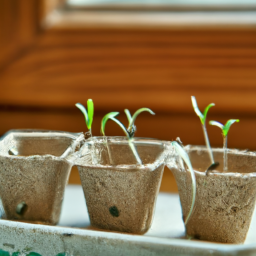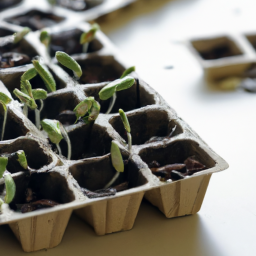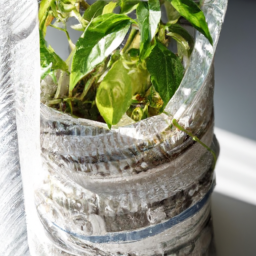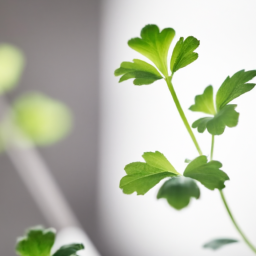
Are you looking to give your seedlings the best start possible? Choosing the right light source is crucial for their growth and development. In this blog post, we will discuss the best light for seedlings and how to ensure they receive the proper amount of light to thrive. Whether you are a seasoned gardener or just starting out, understanding the importance of light for seedlings is key to successful plant growth. Let’s dive in and discover the best options for providing your seedlings with the light they need to flourish.
Choosing the Best Light Spectrum for Seedlings
When it comes to growing healthy and strong seedlings, providing the right light spectrum is crucial. Different plants require different types of light for optimal growth, so it’s important to choose the best light for your specific seedlings. In this guide, we will discuss the different light spectrums available and how to choose the best one for your seedlings.
Understanding Light Spectrum
Light spectrum refers to the range of wavelengths of light that are emitted by a light source. Different wavelengths of light have different effects on plant growth and development. The two main types of light spectrum that are important for seedlings are blue light and red light.
Blue light has a shorter wavelength and is essential for seedling growth. It promotes strong stem and leaf growth, as well as overall plant health. Red light, on the other hand, has a longer wavelength and is important for flowering and fruiting. Both blue and red light are necessary for healthy plant growth, so it’s important to provide a light source that emits both types of light.
When choosing a light source for your seedlings, look for a full spectrum grow light that emits both blue and red light. This will ensure that your seedlings receive the right balance of light for optimal growth.
Types of Grow Lights
There are several types of grow lights available on the market, each with its own advantages and disadvantages. The most common types of grow lights for seedlings are fluorescent, LED, and high-intensity discharge (HID) lights.
Fluorescent lights are a popular choice for seedlings because they are energy-efficient and emit a balanced spectrum of light. They are also affordable and easy to use, making them a great option for beginner gardeners. LED lights are another popular choice for seedlings, as they are energy-efficient and long-lasting. They also emit a full spectrum of light, making them ideal for seedling growth.
HID lights are the most powerful grow lights available, but they are also the most expensive. They emit a strong spectrum of light that is ideal for flowering and fruiting plants. If you are growing a large number of seedlings or plants that require a lot of light, HID lights may be the best option for you.
Choosing the Best Light for Your Seedlings
When choosing a light for your seedlings, consider the type of plants you are growing and their specific light requirements. Some plants may require more blue light for strong growth, while others may need more red light for flowering.
It’s also important to consider the size of your growing space and the number of seedlings you are growing. If you have a small space or are only growing a few seedlings, a fluorescent or LED light may be sufficient. If you have a larger space or are growing a large number of seedlings, you may need a more powerful light source like an HID light.
Ultimately, the best light for your seedlings will depend on your specific growing conditions and the needs of your plants. By understanding the different types of light spectrum and grow lights available, you can choose the best light for your seedlings and help them grow into healthy, strong plants.

Comparing Different Types of Grow Lights for Seedlings
When it comes to growing healthy seedlings indoors, choosing the right grow lights is crucial. With so many options available on the market, it can be overwhelming to decide which type of grow light is best for your seedlings. In this guide, we will compare different types of grow lights to help you make an informed decision.
Fluorescent Grow Lights
Fluorescent grow lights are a popular choice for seedlings due to their affordability and energy efficiency. They come in two main types: T5 and T8. T5 fluorescent lights are more efficient and produce more light per watt compared to T8 lights. They are also available in different spectrums, such as cool white, warm white, and daylight, making them versatile for different stages of plant growth.
One of the drawbacks of fluorescent grow lights is that they have a limited lifespan and may need to be replaced more frequently compared to other types of grow lights. Additionally, they do not produce as much light intensity as other types of grow lights, which may be a concern for seedlings that require high light levels.
Overall, fluorescent grow lights are a good option for beginners or for those on a budget. They are easy to set up and provide adequate light for most seedlings. However, if you are growing light-hungry plants or need higher light intensity, you may want to consider other types of grow lights.
LED Grow Lights
LED grow lights have gained popularity in recent years due to their energy efficiency and long lifespan. They are available in a wide range of spectrums, including full spectrum, red/blue, and white light. LED grow lights are also adjustable, allowing you to customize the light intensity and spectrum based on the needs of your seedlings.
One of the main advantages of LED grow lights is their low heat output, which reduces the risk of burning your seedlings. They also have a higher light intensity compared to fluorescent lights, making them suitable for light-hungry plants. However, LED grow lights tend to be more expensive upfront compared to other types of grow lights.
Overall, LED grow lights are a great option for serious indoor gardeners who want to invest in high-quality lighting for their seedlings. They are energy-efficient, long-lasting, and provide the flexibility to customize the light spectrum and intensity for optimal plant growth.
High-Intensity Discharge (HID) Grow Lights
HID grow lights, such as metal halide (MH) and high-pressure sodium (HPS) lights, are known for their high light intensity and ability to promote vigorous plant growth. MH lights emit a bluish-white light that is ideal for vegetative growth, while HPS lights produce a reddish-orange light that is best for flowering and fruiting stages.
One of the drawbacks of HID grow lights is their high heat output, which can be a concern for seedlings if not properly ventilated. They also consume more energy compared to LED grow lights, resulting in higher electricity bills. Additionally, HID grow lights have a shorter lifespan and may require more frequent replacement.
Despite these drawbacks, HID grow lights are a popular choice for commercial growers and enthusiasts who want to achieve maximum yields. They are suitable for a wide range of plants and provide the high light intensity needed for healthy seedling growth. However, they may not be the most cost-effective option for small-scale growers or those looking to minimize energy consumption.

Tips for Using LED Grow Lights for Optimal Seedling Growth
When it comes to growing healthy seedlings indoors, choosing the right lighting is crucial for their development. LED grow lights have become increasingly popular among indoor gardeners due to their energy efficiency and customizable spectrum. Here are some tips for using LED grow lights to ensure optimal seedling growth.
1. Choose the Right Spectrum
LED grow lights come in a variety of spectrums, each designed to support different stages of plant growth. For seedlings, it is best to use a full spectrum LED grow light that includes both blue and red light wavelengths. Blue light promotes vegetative growth, while red light stimulates flowering and fruiting. By providing a balanced spectrum, you can ensure that your seedlings receive the light they need to thrive.
It is also important to consider the intensity of the light. Seedlings require lower light intensity compared to mature plants, so be sure to adjust the height of the LED grow light accordingly. Too much light can lead to stunted growth or even damage to the seedlings, so it is important to find the right balance.
In addition to the spectrum and intensity, the duration of light exposure is also crucial for seedling growth. Most seedlings require around 14-16 hours of light per day, so be sure to set a timer to ensure they receive the proper amount of light each day.
2. Position the Lights Properly
When using LED grow lights for seedlings, it is important to position the lights at the correct distance from the plants. LED grow lights emit less heat compared to traditional grow lights, but they can still cause heat stress if placed too close to the seedlings. A good rule of thumb is to position the lights around 12-18 inches above the seedlings, and adjust as needed based on the specific requirements of your plants.
It is also important to ensure that the light is evenly distributed across all of the seedlings. If some seedlings are receiving more light than others, it can lead to uneven growth and development. Consider using reflective surfaces or rotating the trays regularly to ensure that all seedlings receive an equal amount of light.
Lastly, be mindful of any obstructions that may block the light from reaching the seedlings. Make sure that the lights are not blocked by other plants or objects, as this can prevent the seedlings from receiving the light they need to grow properly.
3. Monitor and Adjust as Needed
Even with the best LED grow lights, it is important to monitor your seedlings regularly and make adjustments as needed. Keep an eye on the growth and development of your seedlings, and be on the lookout for any signs of stress or deficiencies.
If you notice that your seedlings are stretching towards the light or becoming leggy, it may be a sign that they are not receiving enough light. In this case, you may need to increase the intensity of the light or decrease the distance between the lights and the plants.
On the other hand, if you notice that your seedlings are becoming discolored or showing signs of burning, it may be a sign that they are receiving too much light. In this case, you may need to decrease the intensity of the light or increase the distance between the lights and the plants.
By monitoring your seedlings closely and making adjustments as needed, you can ensure that they receive the optimal amount of light for healthy growth and development.
Here’s what we learned
When it comes to growing healthy seedlings, choosing the right light source is crucial. Seedlings need plenty of light to thrive, especially during their early stages of growth. The best light for seedlings is typically a full spectrum grow light, which mimics the natural sunlight that plants need to photosynthesize effectively. These lights provide the right balance of red, blue, and white light to promote strong, healthy growth.
LED grow lights are also a popular choice for seedlings, as they are energy-efficient and produce less heat than traditional fluorescent lights. This can help prevent the seedlings from becoming too hot and drying out. When setting up your grow lights for seedlings, make sure they are positioned close enough to the plants to provide adequate light coverage, but not too close that they risk burning the delicate leaves. With the right light source and proper care, your seedlings will be well on their way to becoming healthy, thriving plants.
Frequently Asked Questions from our readers:
Q1: What is the best type of light for seedlings?
The best type of light for seedlings is a full spectrum LED grow light. This type of light provides the necessary spectrum of light for optimal seedling growth.
Q2: How far should the light be from the seedlings?
The light should be placed about 2-4 inches above the seedlings to ensure they receive enough light without getting burned.
Q3: How long should seedlings be exposed to light each day?
Seedlings should be exposed to light for about 14-16 hours per day to mimic natural sunlight and promote healthy growth.
Q4: Can I use a regular light bulb for seedlings?
Regular light bulbs do not provide the full spectrum of light that seedlings need for optimal growth. It is best to use a specialized LED grow light designed for plants.
Q5: How can I determine if my seedlings are getting enough light?
You can tell if your seedlings are getting enough light by observing their growth. If they are tall and spindly, they may not be getting enough light. Healthy seedlings will have sturdy stems and vibrant green leaves.
Dr. Olivia Green is a botanist with over two decades of experience in indoor plant cultivation. She holds a Ph.D. in Plant Biology and has dedicated her career to researching plant behavior in controlled environments. Dr. Green is passionate about helping plant enthusiasts master the art of indoor gardening through her extensive knowledge and practical insights.


